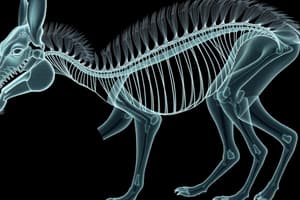Podcast
Questions and Answers
What is the broadest category in the hierarchy of animal classification?
What is the broadest category in the hierarchy of animal classification?
- Domain (correct)
- Phylum
- Kingdom
- Class
Which phylum includes animals that have a notochord?
Which phylum includes animals that have a notochord?
- Mollusca
- Annelida
- Chordata (correct)
- Porifera
What type of behavior is defined as genetically programmed actions?
What type of behavior is defined as genetically programmed actions?
- Foraging Behavior
- Social Behavior
- Innate Behavior (correct)
- Learned Behavior
Which classification approach uses genetic data to determine evolutionary relationships?
Which classification approach uses genetic data to determine evolutionary relationships?
What is a key characteristic of social behavior in animals?
What is a key characteristic of social behavior in animals?
In which of the following behaviors do animals acquire knowledge through experience?
In which of the following behaviors do animals acquire knowledge through experience?
Which phylum includes snails and clams?
Which phylum includes snails and clams?
What aspect of animal behavior examines the ecological and evolutionary basis for behavior?
What aspect of animal behavior examines the ecological and evolutionary basis for behavior?
Flashcards are hidden until you start studying
Study Notes
Animal Classification
- Definition: The systematic grouping of animals based on shared characteristics.
- Hierarchy of Classification:
- Domain: Broadest category (e.g., Eukarya).
- Kingdom: Major groups (e.g., Animalia).
- Phylum: Groups based on body plans (e.g., Chordata).
- Class: Further division (e.g., Mammalia).
- Order: Groups within a class (e.g., Carnivora).
- Family: More specific (e.g., Felidae).
- Genus: Closely related species (e.g., Panthera).
- Species: Basic unit of classification (e.g., Panthera leo for lions).
- Major Phyla in Animal Kingdom:
- Porifera: Sponges.
- Cnidaria: Jellyfish, corals, and sea anemones.
- Mollusca: Snails, clams, and octopuses.
- Annelida: Segmented worms.
- Arthropoda: Insects, arachnids, and crustaceans.
- Chordata: Animals with a notochord, including vertebrates.
- Modern Classification Approaches:
- Phylogenetics: Uses genetic data to determine evolutionary relationships.
- Cladistics: Classifies animals based on shared derived characteristics.
Animal Behavior
- Definition: The study of how animals interact with each other and their environment.
- Types of Behavior:
- Innate Behavior: Genetically programmed actions (e.g., reflexes).
- Learned Behavior: Acquired through experience (e.g., problem-solving).
- Social Behavior: Interactions among individuals (e.g., mating rituals, pack hunting).
- Key Concepts:
- Instincts: Complex behaviors that are hardwired and occur without learning.
- Imprinting: A form of learning occurring at a specific life stage (e.g., ducklings following the first moving object).
- Communication: Various methods (visual, auditory, chemical) used by animals to convey information.
- Foraging Behavior: Strategies for locating and obtaining food (e.g., solitary vs. group foraging).
- Behavioral Ecology:
- Examines the ecological and evolutionary basis for animal behavior.
- Focuses on how behaviors evolve in response to environmental pressures.
- Conservation Behavior: Study of how behavior impacts conservation efforts and species survival (e.g., habitat selection, mating systems).
Animal Classification
- Systematic grouping of animals based on shared characteristics.
- Hierarchy of Classification includes domains, kingdoms, phyla, classes, orders, families, genera, and species, with species as the basic unit.
- Major Phyla in Animal Kingdom:
- Porifera: Includes sponges, simple aquatic organisms.
- Cnidaria: Comprises jellyfish, corals, and sea anemones, known for stinging cells.
- Mollusca: Encompasses snails, clams, and octopuses, featuring soft bodies and often hard shells.
- Annelida: Segmented worms with bodies divided into segments, like earthworms.
- Arthropoda: Largest phylum including insects, arachnids, and crustaceans, characterized by exoskeletons.
- Chordata: Includes all animals possessing a notochord, primarily vertebrates.
- Modern Classification Approaches:
- Phylogenetics uses genetic data to explore evolutionary relationships.
- Cladistics focuses on classifying organisms based on shared derived traits.
Animal Behavior
- The study of interactions between animals and their environment, including social dynamics.
- Types of Behavior:
- Innate Behavior: Actions that are genetically programmed and do not require learning.
- Learned Behavior: Behaviors acquired through individual experience and conditioning.
- Social Behavior: Includes interactions related to reproduction and survival, like mating and hunting in groups.
- Key Concepts:
- Instincts are complex behaviors that are hardwired and do not require prior experience.
- Imprinting: A developmental phase learning where certain animals recognize and follow a figure, such as ducklings.
- Communication: Various methods animals use to share information, which can be visual, auditory, or chemical.
- Foraging Behavior: Strategies animals use to find and secure food, which may vary between solitary and social contexts.
- Behavioral Ecology:
- Examines the interaction between ecological factors and the evolution of animal behavior.
- Focuses on behavioral adaptations in response to environmental changes and challenges.
- Conservation Behavior: Investigates the connection between animal behavior and conservation efforts, considering factors like habitat selection and mating strategies.
Studying That Suits You
Use AI to generate personalized quizzes and flashcards to suit your learning preferences.




